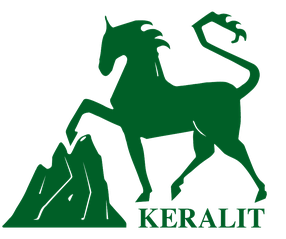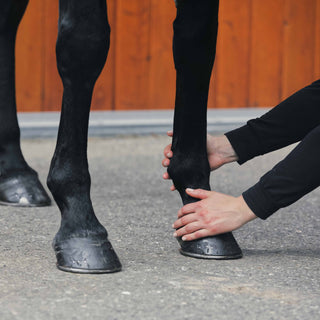There are several forms of hoof dermatitis, roughly divided into a septic and an aseptic form. The different forms arise from various causes. However, similar symptoms can also occur in conjunction with acute laminitis or chronic laminitis.
Septic dermatitis of the hoof
The septic form occurs when germs enter the hoof. They spread in the area of the white line and the sole after these have been injured. This can be caused by foreign bodies such as nails or sharp stones or as a result of hoof abscesses. Treatment, course of the disease and prognosis are therefore similar to those of hoof abscesses.

Fig. 1: Septic dermatitis of the hoof, already healing
Treating septic hoof dermatitis
In the acute phase, this form of hoof inflammition of the dermis is definitely a case for medical intervention, similar to a hoof abscess. The vet decides whether and to what extent the focus of inflammation needs to be opened for drainage and whether antibiotics need to be administered. Subsequently the sole area should be well protected during the healing phase. One option is for the farrier to make a so-called hospital plate, which allows the wound area to be easily reached and the wound to be treated and then protected again by simply screwing on a metal plate. Such systems are available in various prefabricated versions.

Similar systems can also be utilized with adhesive or plastic shoes. In these cases it is important to use shoes with a rigid metal core, as any deformation of the hoof - including that of the normal hoof mechanism - causes pain to the horse, at least in the initial phase. prepares.
In principle, a hoof boot is also an option. However, it should be noted that many hoof boots are secured over the fetlock and heel bulbs of the foot by clamping with straps or buckles. This means that they are not suitable for permanent fixation during stall rest.
Aseptic hoof dermatitis
In the aseptic form, the cause is always irritation of the hoof corium - whether shod or barehoof. This can also be caused by shoeing. Aseptic dermatitis can occur in barehoofed horses due to hooves that are too short. However, sole dermatitis also occurs in shod horses. This is caused when the hoof trimmer trims too much of the wall and sole or hot-fits the shoe for too long. The sensitivity of horses varies greatly. Care should be taken here and the horse should be moved on soft ground at most.


Special features for barehoofed horses
Bare hooves need a firm and stable hoof sole, as the entire body weight and the rider's weight rests on the hooves. After a jump, this can be up to 3000 kg on one hoof when landing.
The hoof corium does not usually become inflamed as a result of landing on a sharp stone. It is more likely to be caused by prolonged irritation on stony or hard ground. This can happen either during ride-outs or in the paddock.
Other favorable factors are prolonged drought or frost. These weather conditions harden the ground in pastures and paddocks. This can quickly lead to hoof dermatitis.


Fig. 4: Heavily worn horn wall. The horse only walks on the sole
The horses then move increasingly touchy. Horses with flat hooves and little sole curvature are particularly sensitive here. Any stone can cause pressure in such a case. On a hoof with a higher sole arch, the sole comes into much less contact with the ground.
Paved paths with gravel or even crushed stone are very bad for bare hooves. Here it is not the ground that gives way, only the hoof does, e.g. tarred paths with stones on them. This can also lead to larger wall breakouts. With a bare hoof, these paths should therefore always be avoided. It is therefore important that the ground is rather yielding.
In barehoof horses, a healthy balance between abrasion and regrowth of horn on the sole and bearing edge is crucial. If there is an imbalance here, where more horn is worn off than grows back, this inevitably leads to a sole that is too thin.
Reduce abrasion on walls and soles
This can be remedied by using the Keralit Hoof Strengthenerwhich stabilizes the horn of the wall, white line and sole and thus protects against chipping and increased abrasion. Thanks to the Keralit Hoof Strengthener, many horses can get along without horseshoes without any problems. The transition to bare hooves is also much easier.



